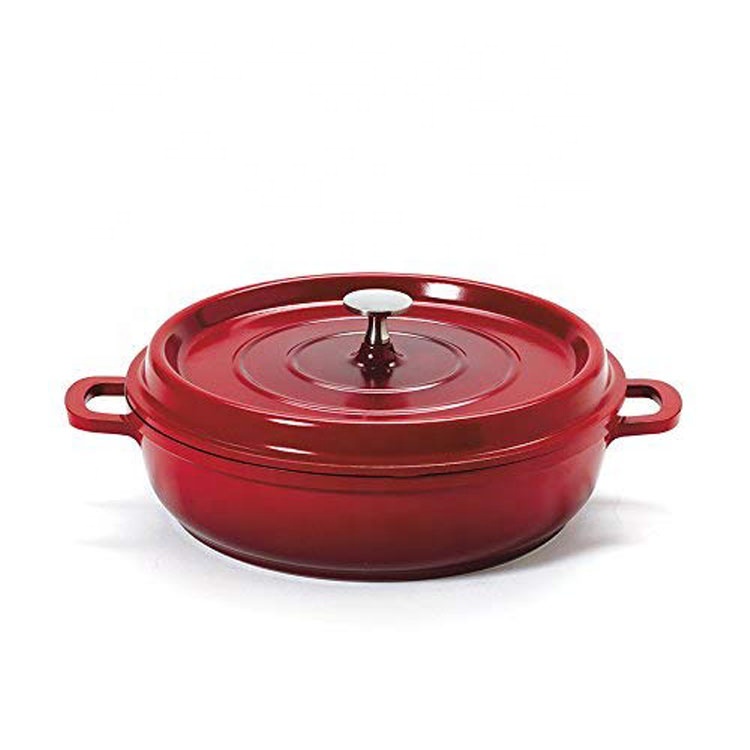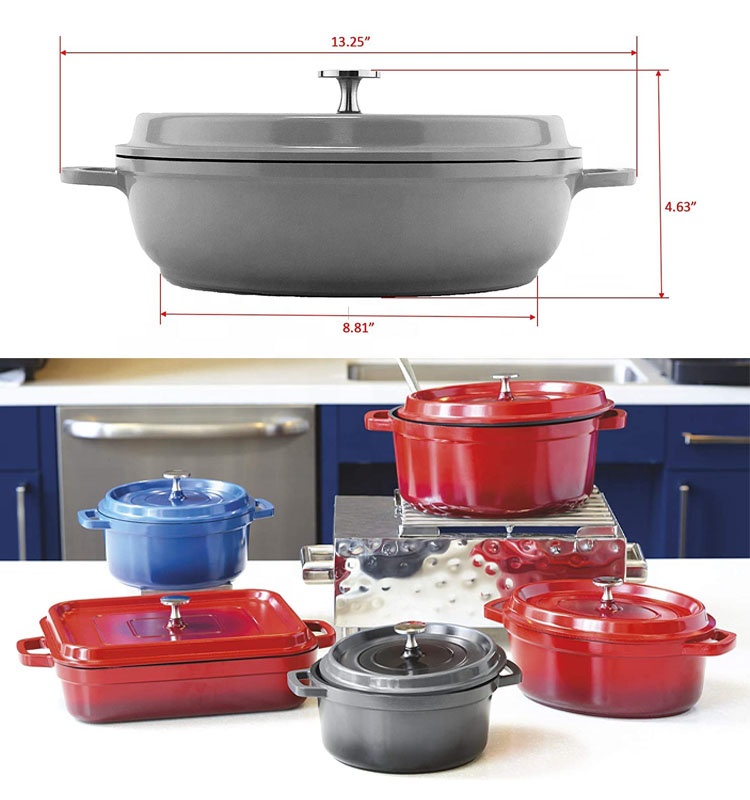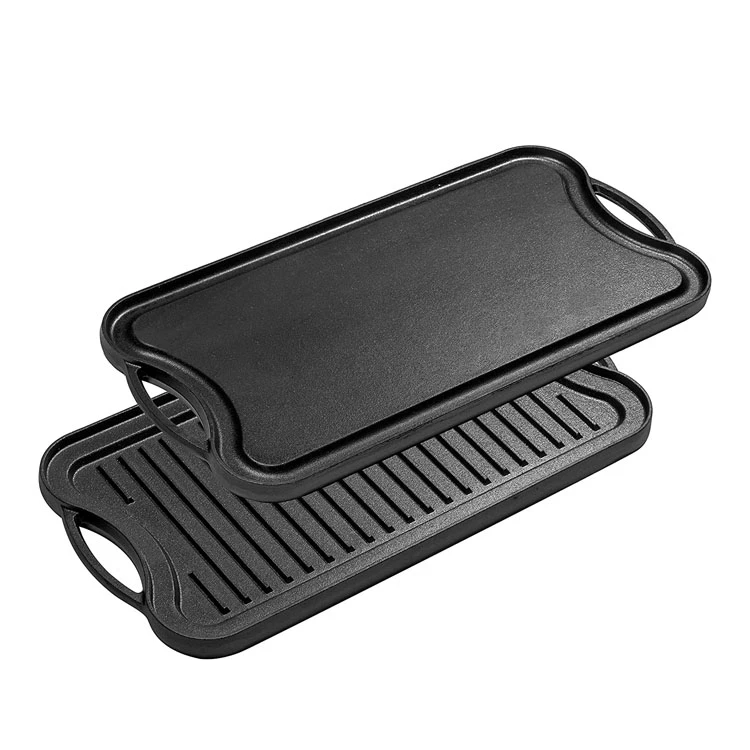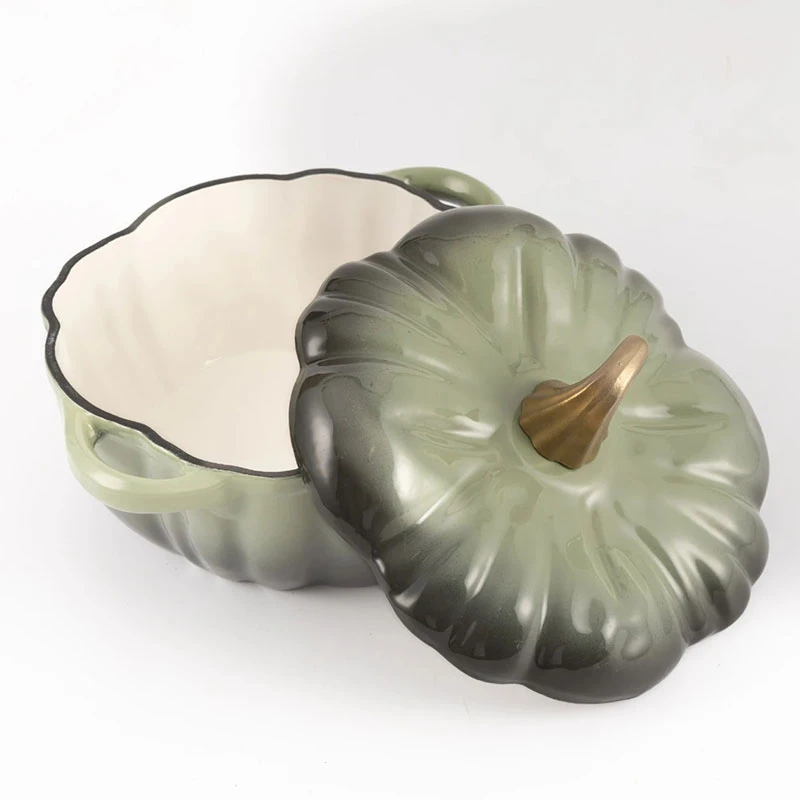
Premium Cast Iron Dutch Oven Pot | Durable & Versatile Cookware
Introduction to Advanced Cast Iron Cookware and Industry Trends
In the specialized realm of B2B culinary equipment and industrial thermal processing, the demand for robust, efficient, and versatile cooking vessels remains paramount. Central to this requirement is the dutch oven pot cast iron, a cornerstone in professional kitchens, catering services, and even specific industrial applications demanding precise thermal management. These units, exemplified by products like the Cast Iron Enameled Casserole Dutch Oven Round Enamel Cast-Iron Cocotte, offer unparalleled heat retention and distribution, making them indispensable.
Current industry trends highlight a significant push towards sustainability, enhanced durability, and multi-functional design in professional cookware. Manufacturers and procurement specialists are increasingly seeking solutions that offer a long service life, reduce energy consumption, and withstand rigorous use in high-volume environments. The versatility of a comprehensive dutch oven cookware set, capable of handling everything from slow-cooked stews to artisan bread baking, aligns perfectly with the evolving needs of the modern culinary sector. Furthermore, niche markets are emerging, with interest in specialized versions such as the compact tiny dutch oven for individual portions or specialized sauces, and rugged outdoor dutch oven models designed for expeditionary catering and open-flame cooking. These trends underscore a strategic shift towards high-performance, adaptable cast iron solutions that deliver both operational efficiency and culinary excellence.
The Advanced Manufacturing Process of Cast Iron Dutch Ovens
The production of a high-quality dutch oven pot cast iron involves a sophisticated sequence of engineering and metallurgical processes, ensuring both structural integrity and superior performance. Adherence to international standards such as ISO 9001 for quality management and specific material certifications is crucial throughout each stage.
Manufacturing Process Flow:
- Material Selection & Preparation: High-grade virgin pig iron, meticulously selected steel scrap, and precise alloying elements (carbon, silicon, manganese) are sourced. These materials undergo rigorous chemical analysis to ensure compliance with metallurgical specifications, ensuring the desired microstructure for optimal strength and heat retention.
- Melting & Alloying: Raw materials are melted in advanced induction furnaces. This controlled environment allows for precise temperature regulation and the introduction of specific alloying agents, enhancing the iron's properties. The molten iron typically reaches temperatures exceeding 1400°C.
- Mold Preparation (Sand Casting): Precision molds are created using a blend of silica sand, binders, and water. These molds are designed to exacting specifications using CAD/CAM systems, ensuring consistent wall thickness and intricate detailing. The sand casting process is preferred for its ability to produce complex shapes and excellent surface finishes for subsequent enameling.
- Pouring: The molten cast iron is poured into the prepared sand molds under carefully controlled conditions. Automated pouring systems minimize defects, ensuring uniform density and preventing inclusions.
- Cooling & Shakeout: After solidification, the castings are allowed to cool gradually to prevent thermal stress. Once cooled, the molds are broken apart, and the raw cast iron components are extracted.
- Fettling & Grinding: Excess metal (gates, risers, flash) is meticulously removed. This stage involves both manual and automated grinding and fettling processes to achieve a smooth, defect-free surface, critical for enamel adhesion.
- Shot Blasting: The cleaned cast iron pieces undergo shot blasting to create a micro-rough surface profile. This mechanical preparation significantly improves the adhesion of the subsequent enamel layers.
- Enameling Application: This multi-stage process involves:
- Pre-treatment: Thorough cleaning to remove any contaminants.
- Ground Coat Application: A specialized glass frit (silicate-based) is applied and fired at high temperatures (typically 750-850°C), creating a strong bond with the cast iron.
- Cover Coat Application: One or more layers of colored or transparent enamel are applied and fired, providing the desired aesthetic, non-reactive surface, and additional protective properties.
- Rim Finishing: The rim is typically left as raw cast iron or receives a specific finish to prevent chipping and ensure robustness.
- Quality Control & Testing: Each dutch oven pot cast iron undergoes rigorous inspection. This includes visual inspection for enamel defects, adhesion testing (e.g., cross-cut test), thermal shock resistance (e.g., rapid heating/cooling cycles), corrosion resistance, and dimensional accuracy. Products conform to international standards such as ANSI, ISO, and relevant food safety regulations like FDA and LFGB.
This meticulous process ensures a service life often exceeding decades under proper usage, making these vessels a sustainable investment. Target industries include petrochemical (for controlled heating), metallurgy (laboratory applications), and extensively in the HORECA sector (Hotels, Restaurants, Cafes) and advanced water supply & drainage systems where heat exchange and corrosion resistance are critical. Key advantages include energy saving due to superior heat retention and exceptional corrosion resistance from the vitreous enamel coating.

Image 1: Precision Casting for a high-performance dutch oven pot cast iron.
Technical Specifications and Material Science Excellence
The performance of a dutch oven pot cast iron is fundamentally dictated by its technical specifications and the advanced material science behind its construction. The combination of high-grade cast iron and a robust enamel coating creates a cooking vessel that excels in heat management and durability.
Material Properties:
- Cast Iron Core: Known for its exceptional thermal mass and conductivity, cast iron ensures superior heat retention and even heat distribution. This prevents hot spots, promoting uniform cooking and energy efficiency. Its robust microstructure contributes to the vessel's overall longevity.
- Vitreous Enamel Coating: This glass-based coating is fused to the cast iron at high temperatures, creating a smooth, non-porous, and non-reactive surface. It provides resistance to acids, alkalis, and odors, making it ideal for a wide range of ingredients. The enamel is also highly resistant to chipping, scratching, and staining, extending the product's aesthetic and functional life.
Key Technical Parameters:
Below is a typical specification table for a premium Cast Iron Enameled Casserole Dutch Oven, highlighting critical parameters that B2B buyers should consider.
| Parameter | Specification | Technical Standard/Certification |
|---|---|---|
| Material Composition | High-grade Grey Cast Iron (GG20/GG25 equivalent), Vitreous Enamel Coating | ASTM A48, EN 1561 |
| Capacity Range | 2.5 Liters to 7 Liters (Customizable) | — |
| Operating Temperature Range | -20°C to +260°C (Oven Safe) | ISO 2871, EN 10088 |
| Wall Thickness | Typically 4.0mm - 6.0mm (Consistent) | ANSI B16.5 |
| Enamel Hardness | Mohs 5-6 (Excellent Scratch Resistance) | EN 102 |
| Thermal Shock Resistance | ΔT > 200°C (No cracking after multiple cycles) | ISO 2747 |
| Corrosion Resistance | Excellent against acids (e.g., vinegar, lemon juice) | ASTM B117 (Salt Spray Test) |
| Food Contact Safety | Lead-free, Cadmium-free, PFOA/PTFE-free | FDA, LFGB, CA Prop 65 |
These specifications underscore the precision engineering and material integrity that define a professional-grade dutch oven pot cast iron, making it a reliable choice for demanding B2B applications.
Diverse Application Scenarios and Technical Advantages
The inherent design and material advantages of a high-quality dutch oven pot cast iron lend themselves to an expansive array of application scenarios, particularly within B2B contexts where performance, efficiency, and durability are paramount.
Target Industries & Key Applications:
- HORECA Sector (Hotels, Restaurants, Cafes): Indispensable for slow-cooking stews, braising meats, baking artisan bread, and preparing large batches of soups and sauces. The even heat distribution and retention ensure consistent results across numerous servings.
- Catering Services & Institutional Kitchens: Ideal for batch cooking due to its capacity and ability to maintain serving temperatures efficiently. Specialized `tiny dutch oven` units are often used for individual dessert preparations or unique serving presentations.
- Specialty Retailers & Home Goods Manufacturers: Often featured in premium `dutch oven cookware set` offerings, targeting discerning home chefs who demand professional-grade equipment.
- Outdoor & Expeditionary Equipment Suppliers: Robust `outdoor dutch oven` variants, often constructed from raw, pre-seasoned cast iron, are critical for open-fire cooking in rugged environments, offering reliability and durability under extreme conditions.
- Industrial Laboratories & Chemical Processing: Smaller, specialized cast iron vessels can be used for controlled heating of substances, requiring precise thermal stability and chemical inertness, especially with an enamel coating.
Technical Advantages:
- Energy Saving: The significant thermal mass of cast iron allows it to retain heat exceptionally well. This means less energy is required to maintain desired cooking temperatures, leading to reduced energy consumption in commercial kitchens. Data suggests up to 20% energy savings compared to lighter cookware over extended cooking periods.
- Superior Heat Distribution: Cast iron heats slowly but very evenly, eliminating hot spots. This characteristic is crucial for consistent cooking, preventing food from burning in one area while being undercooked in another.
- Corrosion Resistance: The multi-layer vitreous enamel coating provides an impermeable barrier, protecting the cast iron from rust and corrosive food acids. This extends the lifespan of the cookware significantly, reducing replacement costs for businesses.
- Exceptional Durability: Built to withstand the rigors of commercial use, these vessels resist warping, denting, and scratching, maintaining their performance and aesthetic appeal for many years.
- Versatility: Suitable for all heat sources, including induction, gas, electric, ceramic, and oven use up to 260°C. Its ability to transition seamlessly from stovetop to oven to table makes it a highly versatile tool in any professional setting.
- Non-Reactive Surface: The enameled interior ensures that no metallic flavors leach into food, preserving the integrity of delicate ingredients and complex flavor profiles.

Image 2: An enameled cast iron Dutch oven in a professional kitchen setting.
Vendor Comparison and Customized Solutions
When evaluating suppliers for a dutch oven pot cast iron, B2B decision-makers must consider several factors beyond just the initial cost. Quality control, adherence to certifications, customization capabilities, and post-purchase support are critical for long-term operational efficiency and brand reputation.
Comparative Analysis: Enameled vs. Raw Cast Dutch Oven
The market offers both enameled and traditional, raw cast dutch oven types. Each has distinct advantages depending on the application.
| Feature | Enameled Dutch Oven | Raw/Pre-Seasoned Cast Iron Dutch Oven |
|---|---|---|
| Surface | Smooth, non-porous vitreous enamel | Porous, seasoned with oil/fat (polymerized layer) |
| Maintenance | Easy to clean, no seasoning required, dishwasher safe (check manufacturer) | Requires regular seasoning, hand wash only, careful drying to prevent rust |
| Reactivity | Non-reactive, safe for acidic foods | Can react with highly acidic foods if seasoning is weak |
| Corrosion Resistance | Excellent due to enamel coating | Dependent on seasoning layer; susceptible to rust if not maintained |
| Aesthetics | Wide range of colors, glossy finish, ideal for table service | Classic black, rustic, industrial look |
| Best Use Cases | Slow cooking, braising, soups, baking, general purpose; HORECA | Frying, searing, deep-frying, outdoor cooking; `outdoor dutch oven` |
Customized Solutions for B2B Clients:
Leading manufacturers understand that off-the-shelf solutions may not always meet specific operational or branding requirements. Therefore, offering comprehensive ODM (Original Design Manufacturing) and OEM (Original Equipment Manufacturing) services is crucial.
- Brand Integration: Custom logo embossing or debossing on lids and bases, allowing for seamless brand integration for retail partners or institutional clients.
- Color & Finish Customization: Tailored enamel colors and finishes to match corporate branding or specific product lines, offering a distinct visual identity.
- Specific Dimensions & Capacities: Custom tooling for unique pot sizes and capacities, addressing specialized menu requirements or kitchen space constraints (e.g., custom `tiny dutch oven` for specific serving sizes).
- Handle & Lid Design: Ergonomic handle designs, specific knob materials, or lid features (e.g., self-basting spikes) can be customized to enhance user experience and functionality.
- Packaging Solutions: Bespoke packaging design, including branding, protective inserts, and bulk shipping solutions tailored to distribution channels.
By offering these customization options, manufacturers can serve a wider array of clients, from boutique hotel chains requiring branded cookware to large retailers curating a unique `dutch oven cookware set` for their market.
Application Case Studies and Customer Experience
Real-world application case studies and direct customer feedback provide tangible evidence of the value and performance delivered by a superior dutch oven pot cast iron. These insights highlight the practical benefits and operational improvements experienced by B2B clients.
Case Study 1: High-Volume Restaurant Chain
A national restaurant chain specializing in slow-cooked braised dishes faced challenges with inconsistent cooking results and high energy costs from their previous aluminum stockpots. They transitioned to a fleet of 5-liter dutch oven pot cast iron units.
- Challenge: Inconsistent product quality for braised short ribs and excessive energy consumption.
- Solution: Implemented 300 units of enameled cast iron Dutch ovens across 50 locations.
- Results:
- Quality Improvement: Uniform tenderization and caramelization, leading to a 15% increase in positive customer feedback regarding dish consistency.
- Cost Savings: An estimated 18% reduction in gas consumption due to superior heat retention, translating to significant operational savings annually.
- Durability: After two years, over 95% of the units remained in excellent condition, significantly outperforming the previous cookware's lifespan.
Case Study 2: Specialty Retailer Launching a Premium Cookware Line
A burgeoning kitchenware retailer sought to differentiate its brand by offering a high-end `dutch oven cookware set` under its private label. They partnered with a manufacturer for customized OEM production.
- Challenge: Sourcing high-quality, customizable cast iron cookware that meets stringent food safety standards (FDA/LFGB) and offers distinctive branding.
- Solution: Developed a `dutch oven cookware set` featuring a custom enamel color palette and embossed brand logo on the lid, paired with elegant packaging.
- Results:
- Market Penetration: The exclusive line achieved a 25% market share in its segment within the first year, driven by perceived quality and unique aesthetics.
- Customer Loyalty: High customer satisfaction rates due to the product's performance and premium feel, fostering repeat purchases and positive reviews.
- Brand Reputation: Positioned the retailer as a purveyor of high-quality, durable kitchenware, attracting a more affluent customer base.
Customer Feedback Highlights:
- "The heat retention is phenomenal; our dishes stay warm longer for service, reducing waste." - *Head Chef, Upscale Bistro*
- "The enamel finish is incredibly robust. Even with daily heavy use, it resists chipping and looks new." - *Procurement Manager, Hotel Group*
- "Our clients love the bespoke colors for our branded cast dutch oven. It perfectly matches our aesthetic." - *Product Development Lead, Retailer*

Image 3: Diverse culinary creations made possible by the versatile dutch oven pot cast iron.
Trust and Reliability: Partnering for Success
In the B2B landscape, establishing trust and ensuring reliability are paramount. Our commitment to quality, transparency in operations, and robust customer support underpin every dutch oven pot cast iron we deliver.
Company Certifications & Authoritative Standards:
- ISO 9001 Certified: Our manufacturing facilities operate under a stringent ISO 9001 Quality Management System, ensuring consistent product quality from raw material sourcing to final inspection.
- FDA & LFGB Compliance: All enameled cast iron products meet the rigorous food contact safety standards set by the U.S. Food and Drug Administration (FDA) and the German Food and Feed Code (LFGB), guaranteeing lead-free, cadmium-free, and PFOA/PTFE-free surfaces.
- Years of Service: With X years of specialized experience in cast iron cookware manufacturing, we bring unparalleled expertise and a proven track record to every partnership.
- Partner Clients: We proudly serve a diverse portfolio of international hotel chains, gourmet retailers, and industrial partners, fostering long-term relationships built on trust and consistent product delivery.
Lead Time & Fulfillment:
Our streamlined production processes and efficient supply chain management enable competitive lead times.
- Standard Orders: Typically 30-45 days from order confirmation to shipment, depending on volume and specific product configurations.
- Customized Orders: 45-75 days, accommodating design, tooling, and specific material sourcing requirements.
- Production Capacity: Our facilities are equipped to handle large-scale orders, with a monthly production capacity of over 50,000 units, ensuring consistent supply for major retail and hospitality partners.
Warranty Commitments:
We stand behind the quality of our products with a robust warranty program.
- Limited Lifetime Warranty: Against defects in materials and workmanship under normal household use.
- Commercial Warranty: A comprehensive 5-year commercial warranty covers manufacturing defects under specified commercial usage conditions.
Customer Support & After-Sales Service:
- Dedicated Account Managers: Providing personalized support and streamlined communication for B2B partners.
- Technical Support: Expert assistance for product usage, maintenance, and technical queries.
- Prompt Issue Resolution: A responsive team committed to addressing any concerns efficiently, ensuring minimal disruption to client operations.
Frequently Asked Questions (FAQ):
- Q: Are these Dutch ovens suitable for induction cooktops?
- A: Yes, all our dutch oven pot cast iron models are fully compatible with induction, gas, electric, and ceramic cooktops, as well as oven-safe up to 260°C.
- Q: How should the enameled surface be cleaned?
- A: The enameled interior is designed for easy cleaning. Hand washing with warm, soapy water and a non-abrasive sponge is recommended. For stubborn food residue, soaking in warm water for 15-20 minutes before cleaning is effective. Avoid harsh detergents or metallic scrubbers.
- Q: Can I get custom branding for my order?
- A: Absolutely. We offer extensive ODM/OEM services, including custom logo embossing, specific enamel colors, and tailored packaging solutions to meet your brand's unique requirements.
- Q: What is the average lifespan of your enameled cast iron products in a commercial setting?
- A: With proper care and maintenance, our enameled cast iron Dutch ovens are engineered to provide reliable service for 10-20 years or more in typical commercial kitchen environments, backed by our robust commercial warranty.
Conclusion: The Enduring Value of Cast Iron Dutch Ovens
The dutch oven pot cast iron stands as a testament to enduring design, superior material science, and meticulous craftsmanship. For B2B stakeholders in culinary, hospitality, and even specialized industrial sectors, investing in these advanced cooking vessels translates directly into operational efficiency, cost savings, and elevated product quality. From the precise control offered by its thermal properties to the robust protection of its vitreous enamel, every aspect is engineered for high performance and longevity.
Our commitment extends beyond merely manufacturing a product; we provide a partnership anchored in quality assurance, customizable solutions, and dedicated support. Whether it's enhancing a restaurant's signature dishes, equipping a new catering venture, or establishing a premium `dutch oven cookware set` for retail, the value proposition of our Cast Iron Enameled Casserole Dutch Oven remains unmatched. By choosing our expertly crafted cast iron solutions, businesses are not just acquiring cookware; they are investing in reliability, innovation, and a legacy of culinary excellence.

Image 4: The enduring quality and versatility of a well-crafted dutch oven pot cast iron.
References
- ASTM International. "Standard Specification for Grey Iron Castings." ASTM A48/A48M.
- International Organization for Standardization. "Quality management systems — Requirements." ISO 9001:2015.
- European Committee for Standardization. "Founding — Grey cast irons." EN 1561:2011.
- U.S. Food and Drug Administration. "Food Contact Substances." 21 CFR 170-199.
- German Food and Feed Code. "Lebensmittel-, Bedarfsgegenstände- und Futtermittelgesetzbuch (LFGB)."
-
Cast Iron Griddle for BBQ Grill: Ultimate Versatility & HeatNewsAug.28,2025
-
Durable Iron Pans for Cooking: Even Heat & Healthy MealsNewsAug.27,2025
-
Made In Cookware Dutch Oven: Cast Iron & Enamel VersatilityNewsAug.21,2025
-
Made In Cookware Dutch Oven: Enameled Cast Iron VersatilityNewsAug.19,2025
-
High Quality Kitchen Durable Black Round Cast Iron Cookware - Baixiang County Zhongda Machinery Manufacturing Co., Ltd.|Non-Stick, Heat Retention, DurableNewsAug.18,2025


